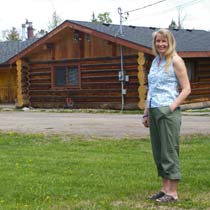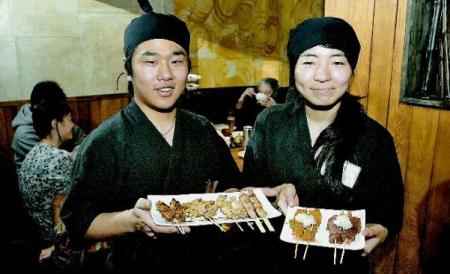With jobs for skilled trades, you can retain your income
Brian Morton
Sun

Susan Miller of Williams Lake Cheryl Engemoen/Special to The Vancouver Sun

Susan Miller and her husband Drew recently moved from Chilliwack to Williams Lake, where they bought a 2,900- squarefoot log home on five acres for $ 270,000. They sold their Chilliwack home for $ 525,000.
If you’re looking for an affordable way of life, just sell your home and head north.
That’s the conclusion of a survey by the B.C. Northern Real Estate Board, which found that despite average house price increases of 30 per cent across northern B.C. last year, owning a home in the region consumes less than half what a homeowner in Vancouver would pay in terms of proportion of household income.
“We know our home prices don’t compare to prices in the Lower Mainland, the Okanagan or Vancouver Island,” BCNREB president Glen Holling said in an interview. “But if you were to move into a northern community and retain your income, you’d find it extremely affordable.”
According to the BCNREB report — commissioned after RBC Financial Group released the results of a cross-Canada housing affordability study showing that B.C. was the least affordable place to buy a house — the Housing Affordability Index (HAI) for northern British Columbia stood at 28.9 per cent, compared to 68.5 per cent for Vancouver and 62.5 per cent for B.C. as a whole.
The index estimates the proportion of pre-tax median household income needed to cover mortgage costs, municipal taxes and fees, and utilities for single-family homes.
What the index means is that the typical household in Vancouver will spend almost 70 per cent of its pre-tax income toward homeownership, while the typical household in northern B.C. spends less than 30 per cent of its pre-tax income on homeownership.
The report notes that the affordability difference has persisted despite recent double-digit increases in prices of single family homes in northern B.C.
Drew and Susan Miller are waiting to move into their 2,900-square-foot log home on two hectares (five acres) in Williams Lake, which they recently bought for $270,000.
The Millers moved to Williams Lake after selling their home in Chilliwack — similar in size to their new log home, but on a three-quarter-acre lot — for $525,000.
“My husband’s company was restructured,” Susan Miller said in an interview on Tuesday. “We weighed our options — our older children live here already — and we thought it was a good time to sell and move to Williams Lake. We both love it here. It put us in a very good position.”
Miller said her husband found work in construction.
“A lot of people from the Lower Mainland are moving up here. A lot of people want to get out of the rat race. There’s a ton of work, and it’s a better atmosphere for kids. And the housing is a lot more affordable.”
The area covered in the survey includes most of B.C. north of Kamloops, including Prince George, 100 Mile House, Williams Lake, Kitimat, Prince Rupert and Fort St. John, but not Dawson Creek, Tumbler Ridge or Chetwynd.
The survey noted that, despite the overall affordability for the area as a whole, there were significant differences between individual towns.
Kitimat had the most affordable housing (14.1 per cent), while homeownership in 100 Mile House consumes the highest proportion (45.6 per cent) of median household income in the area.
The survey notes, however, that housing prices jumped over 50 per cent in the past year in 100 Mile House, lowering that town’s affordability.
Kitimat recorded the lowest housing prices, but significantly higher incomes than other communities in the survey.
The average single family home price in the survey area was in the $190,000 range, with Prince George and 100 Mile House the most expensive.
Holling, who is based in Williams Lake, said word is getting around, with many retirees showing up in northern communities. “We’re seeing strong interest from southern B.C. Some people buy one house to live in and another one to rent. And there’s the retirement income. I think this survey will make more people take note.”
He notes, however, that not everything is affordable. “100 Mile House is less affordable. But it’s a huge recreational property area.”
Holling also said the north’s economy is turning around. “We had a struggle from ’99 to early 2006, but things are starting to turn. We’re seeing mines reopening. And income levels here are quite high in the trades.”
Despite that, there are a number of discrepancies in economic opportunities in northern B.C., according to a Statistics Canada report.
The report noted that among the regions, unemployment rates were just 3.7 per cent in northeast B.C. (the lowest in the province), compared to 8.6 per cent in the North Coast-Nechako (the highest in the province). The Cariboo’s unemployment rate was 5.2 per cent, and the provincial average 4.4 per cent.
The Statistics Canada report also said that during the first three months of 2007, the value of building permits issued in the province increased 15.8 per cent over the same period of last year, with the Cariboo ( 27.2 per cent) standing out in terms of growth. Housing permits rose modestly in the North Coast ( 2.7 per cent), but declined in the northeast (-3.4 per cent) and Nechako (-28.2 per cent).
Fort St. John Mayor Jim Eglinski said in an interview that his community is experiencing strong steady growth because of the oil and gas activity in the area.
“Our community is still facing an economic boom,” he said. “We have a high 90-per-cent fill rate in the hotels and motels all the time. There’s a lot of construction.”
Eglinski said despite the boom, housing in Fort St. John remains very affordable compared to the Lower Mainland. “Up here, the average [single family home] is about $260,000.”
He said anyone with a skilled trade could find work fairly easily. “We have the highest disposable income in B.C. and the second-youngest workforce.”
Prince Rupert Mayor Herb Pond said in an interview that despite a downturn in recent years, the economy there is turning.
“It’s actually a very unique opportunity for young families to enter the real estate market, build equity and have a job. With the coming of the new container port, which will begin operations in October, and the expansion of the cruise ship market, there are some really good work opportunities.”
Pond said Prince Rupert has seen housing price increases of more than 25 per cent in each of the last two years, but “it’s still very reasonable.”
He said the new container port will make Prince Rupert a “significant new entry port to North America for containerized goods from Asia.”
The north becomes a retiree magnet
The survey noted that , despite the overall affordability for the area as a whole, there were significant differences between individual towns.
Kitimat had the most affordable housing ( 14.1 per cent), while homeownership in 100 Mile House consumes the highest proportion ( 45.6 per cent) of median household income in the area.
The survey notes, however, that housing prices jumped over 50 per cent in the past year in 100 Mile House, lowering that town’s affordability.
Kitimat recorded the lowest housing prices, but significantly higher incomes than other communities in the survey.
The average single family home price in the survey area was in the $ 190,000 range, with Prince George and 100 Mile House the most expensive.
Holling, who is based in Williams Lake, said word is getting around, with many retirees showing up in northern communities. “ We’re seeing strong interest from southern B. C. Some people buy one house to live in and another one to rent. And there’s the retirement income. I think this survey will make more people take note.”
He notes, however, that not everything is affordable. “ 100 Mile House is less affordable. But it’s a huge recreational property area.”
Holling also said the north’s economy is turning around. “ We had a struggle from ’ 99 to early 2006, but things are starting to turn. We’re seeing mines reopening. And income levels here are quite high in the trades.”
Despite that, there are a number of discrepancies in economic opportunities in northern B. C., according to a Statistics Canada report.
The report noted that among the regions, unemployment rates were just 3.7 per cent in northeast B. C. ( the lowest in the province), compared to 8.6 per cent in the North CoastNechako ( the highest in the province). The Cariboo’s unemployment rate was 5.2 per cent, and the provincial average 4.4 per cent.
The Statistics Canada report also said that during the first three months of 2007, the value of building permits issued in the province increased 15.8 per cent over the same period of last year, with the Cariboo (+ 27.2 per cent) standing out in terms of growth. Housing permits rose modestly in the North Coast (+ 2.7 per cent), but declined in the northeast (– 3.4 per cent) and Nechako (– 28.2 per cent).
Fort St. John Mayor Jim Eglinski said in an interview that his community is experiencing strong steady growth because of the oil and gas activity in the area.
“ Our community is still facing an economic boom,” he said. “ We have a high 90- percent fill rate in the hotels and motels all the time. There’s a lot of construction.”
Eglinski said despite the boom, housing in Fort St. John remains very affordable compared to the Lower Mainland. “ Up here, the average [ single f a m i l y h o m e ] i s a b o u t $ 260,000.”
He said anyone with a skilled trade could find work fairly easily. “ We have the highest disposable income in B. C. and the second- youngest workforce.”
Prince Rupert Mayor Herb Pond said in an interview that despite a downturn in recent years, the economy there is turning.
“ It’s actually a very unique opportunity for young families to enter the real estate market, build equity and have a job. With the coming of the new container port, which will begin operations in October, and the expansion of the cruise ship market, there are some really good work opportunities.”
Pond said Prince Rupert has seen housing price increases of more than 25 per cent in each of the last two years, but “ it’s still very reasonable.”
He said the new container port will make Prince Rupert a “ significant new entry port to North America for containerized goods from Asia.”
© The Vancouver Sun 2007








